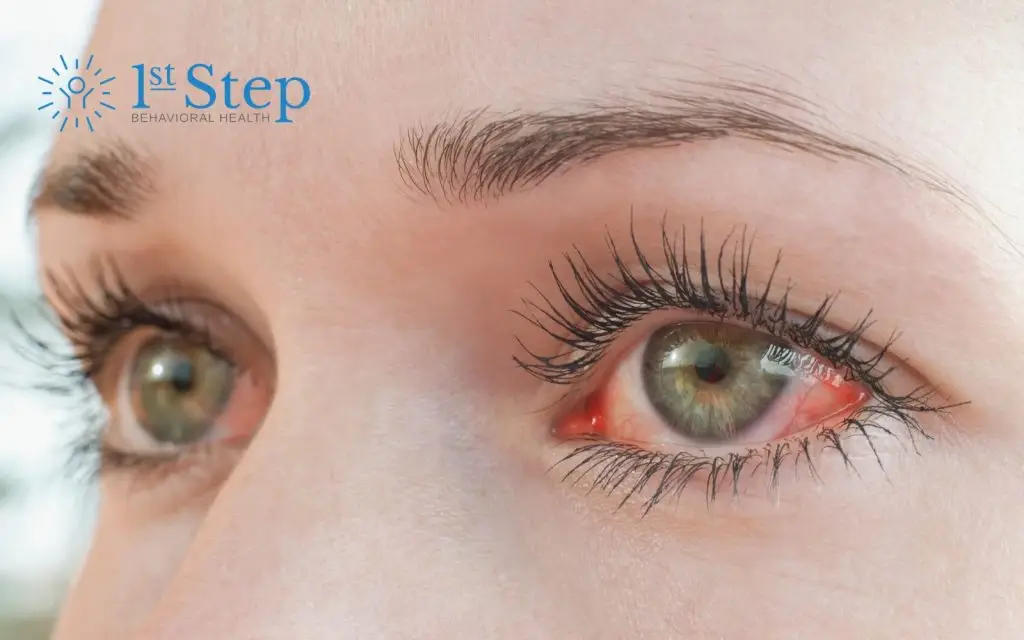Heroin addiction is a growing concern affecting individuals and families across the country. As with any form of substance abuse, early recognition of the signs can play a vital role in seeking help and saving lives.
One of the most noticeable indicators of heroin use is what many refer to as “heroin eyes.” In this article, we’ll explore this symptom in detail—along with other physical, behavioral, and emotional signs of heroin addiction—so you can recognize when it’s time to reach out for help.
What Are “Heroin Eyes”?
The term “heroin eyes” refers to a collection of changes in the eyes that often occur during or after heroin use. These changes are typically easy to spot, especially in people you know well.
Pinpoint Pupils (Eye Miosis)
One of the most defining characteristics of heroin eyes is pinpoint pupils, also known as eye miosis. This condition involves abnormally small pupils, often described as constricted pupils. The pupils appear tiny regardless of how much light is present in the environment.
This effect occurs because heroin activates the mu opioid receptors in the brain, which affects the parasympathetic nervous system—the part of the autonomic nervous system responsible for controlling the body’s rest and digestion functions. As heroin slows down the body, the muscles in the eye that control pupil size tighten, causing the pupils to shrink.
Light Sensitivity and Blurred Vision
Heroin users often report blurred vision and difficulty adjusting to bright light. Since their pupils remain small even in low-light conditions, they can’t regulate how much light enters the eye. This leads to discomfort and sometimes double vision or poor depth perception.
Redness, Dryness, and Eye Pressure
In some cases, users may experience eye pressure, redness, or dryness—especially if heroin is used alongside other drugs or if infections develop. Frequent rubbing of the eyes or use of eye drops may also be a sign that something is wrong.
Why Does Heroin Affect the Eyes?
To understand heroin eyes, it helps to look at how the drug interacts with the body. Heroin is a powerful opioid, derived from morphine, and it acts quickly on the central nervous system. Once it enters the brain, it binds to mu opioid receptors, reducing pain and creating feelings of euphoria.
This interaction also affects various body systems:
- Parasympathetic Nervous System: Causes pupil constriction, slowed heart rate, and decreased breathing.
- Sympathetic Nervous System: Typically prepares the body for “fight or flight,” but heroin suppresses this, leading to a slowed-down state.
- Autonomic Nervous System: Regulates involuntary functions like blinking and tear production—both of which may be altered during heroin use.
When the drug interferes with these systems, heroin eyes become a visible marker of the internal changes taking place.
Other Physical Signs of Heroin Addiction
While the eyes often provide a window into someone’s health, heroin addiction manifests in many physical ways.
Weight Loss
Many individuals with a substance use disorder experience rapid and unhealthy weight loss. Heroin suppresses appetite, disrupts digestion, and leads to poor self-care.
Muscle and Bone Pain
Heroin users frequently report chronic muscle and bone pain. This can worsen during withdrawal and may be mistaken for other health conditions.
Track Marks and Skin Issues
If heroin is injected, marks may appear on the arms or legs. Bruising, sores, and infections are common. Skin picking, often triggered by hallucinations or itching, can lead to scarring and open wounds.
Infectious Diseases
Sharing needles can result in the transmission of infectious diseases like HIV or hepatitis C. These illnesses may not show symptoms right away, but have long-term health consequences.
Behavioral and Emotional Signs of Heroin Use Disorder
In addition to physical symptoms, heroin use disorder deeply impacts behavior and mental well-being.
Social Withdrawal
Many people who use heroin begin isolating themselves from loved ones. They may lose interest in hobbies, work, or responsibilities.
Mood Changes
Heroin can cause intense mood swings—ranging from euphoria to depression. Over time, these fluctuations may deepen into a full-blown use disorder or mental health crisis.
Neglect of Personal Hygiene
Those struggling with heroin abuse often show signs of neglect. Dirty clothes, unwashed hair, and poor dental care are common.
Financial or Legal Trouble
Supporting a heroin habit is expensive. Many users end up in debt, resorting to theft, or facing charges. According to the Drug Enforcement Administration, heroin is a Schedule I drug, meaning it has a high potential for abuse and no accepted medical use in the U.S.
Dangers of Heroin Overdose
A heroin overdose is a life-threatening emergency. If you suspect someone is overdosing, call 911 immediately.
Signs of overdose include:
- Extremely constricted pupils
- Unresponsiveness or loss of consciousness
- Slow or shallow breathing
- Blue or gray lips and fingernails
- Vomiting or gurgling sounds
- Limp body
Overdose is often the result of taking too high a dose, mixing heroin with other opioids or prescription medications, or using heroin with an unknown actual strength. Because of the unpredictability of street drugs, the risk of death is always present.
Withdrawal Symptoms
When someone stops using heroin, withdrawal symptoms usually begin within 6 to 12 hours. These symptoms can be incredibly painful and may include:
- Severe bone pain and muscle aches
- Nausea, vomiting, or diarrhea
- Insomnia
- Sweating and chills
- Anxiety and irritability
- Cravings for the drug
Many people return to heroin use simply to avoid these symptoms, further deepening their addiction and use disorder.
Eye Conditions That Can Be Mistaken for Heroin Eyes
It’s important to note that small pupils or drug-induced miosis can also occur with other substances or health conditions.
These include:
- Prescription medications like opioids or certain anti-anxiety drugs
- Exposure to nerve agents
- Neurological disorders involving the brain stem
- Conditions like myasthenia gravis
- Other underlying conditions related to the eyes or retina
That’s why it’s critical to consult a healthcare provider to determine the cause of any unusual eye symptoms.
Getting Help: Treatment for Heroin Addiction
Recovery is possible. With the right treatment program, individuals struggling with heroin addiction can rebuild their health and lives.
Detox and Medical Support
Medical detox helps people safely navigate withdrawal with the help of trained professionals. Medications may be used to reduce symptoms and manage cravings.
Therapy and Counseling
Cognitive-behavioral therapy, group therapy, and trauma-informed care are effective tools in treating substance use disorder. These services help individuals address the root causes of addiction.
Support Groups and Community
Connecting with others in recovery can provide much-needed encouragement. Peer support groups like Narcotics Anonymous can offer a sense of belonging.
Long-Term Care and Relapse Prevention
Heroin addiction is a chronic condition, much like diabetes or asthma. Ongoing treatment and relapse prevention strategies are essential for long-term recovery.
Recognizing the Signs, Taking the First Step
Whether you’re concerned about a loved one or recognizing symptoms in yourself, it’s crucial not to ignore the signs. Heroin eyes and other symptoms—like muscle and bone pain, social withdrawal, and sudden weight loss—may be cries for help rather than signs of moral failure. Addiction is a health issue, not a character flaw.
The sooner someone receives support, the better the chances for healing and a new beginning. If you or someone you care about is struggling, reach out to a healthcare provider or treatment center today. Your life is worth saving.
If you or a loved one needs support and treatment to overcome substance abuse or addiction, you are not alone. Find the treatment, resources, and support you need at First Step Behavioral Health. Learn about your treatment options or schedule your first appointment by contacting our intake team today.
Frequently Asked Questions (FAQ)
1. Can heroin use cause permanent damage to the eyes or vision?
While short-term heroin use typically causes reversible effects like pinpoint pupils and blurred vision, long-term use may increase the risk of eye infections, damage to the blood vessels in the eyes, and complications from poor hygiene or co-infections like HIV.
Chronic use may also impair vision indirectly through poor nutrition and neglect of general health. Heroin users need to receive comprehensive medical evaluations, including eye exams.
2. Is it possible for someone to hide heroin eyes with eye drops or sunglasses?
Yes, some individuals attempt to mask their heroin eyes using over-the-counter eye drops, sunglasses, or by avoiding eye contact altogether. However, while this may temporarily reduce redness or disguise small pupils, it does not eliminate other visible or behavioral signs of heroin use. Trained professionals or close friends and family often notice changes despite these efforts.
3. Do all opioids cause pinpoint pupils, or is this specific to heroin?
Pinpoint pupils are a common effect of many opioids, including prescription medications like oxycodone, fentanyl, and morphine. This condition, known as drug-induced miosis, is not exclusive to heroin. That’s why medical professionals consider a full range of symptoms and patient history before diagnosing heroin use disorder.
4. Can someone experience withdrawal symptoms even after short-term heroin use?
Yes. Physical withdrawal symptoms can begin after just a few uses of heroin, particularly if the use was consistent over several days. The body adapts quickly to the presence of opioids, and even short-term users may experience discomfort when stopping. Psychological cravings can also develop rapidly.
5. How does heroin compare to other opioids in terms of addiction risk?
Heroin carries a high risk of addiction because it enters the brain quickly, creating a powerful and immediate sense of euphoria. While all opioids can lead to substance use disorder, heroin’s rapid onset and inconsistent street purity (which affects the actual strength) significantly increase the likelihood of dependence, overdose, and death.
6. What role does the brain stem play in heroin overdose deaths?
The brain stem controls vital life functions like breathing and heart rate. Heroin suppresses activity in this region, which can lead to respiratory failure—one of the most common causes of death in heroin overdose. This is why overdoses can be so sudden and why prompt medical attention is critical.
Sources
Jump to a Section
Call (855) 425-4846
